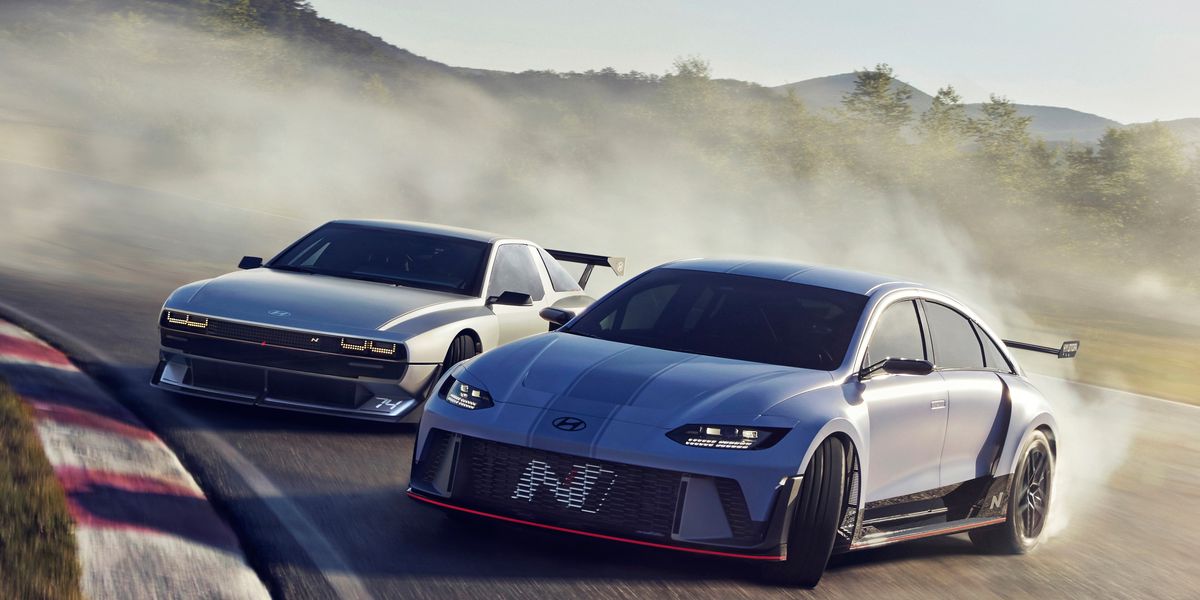Hyundai Confirms Ioniq 5 N, Shows Two Big-Performance EV Concepts

Hyundai has confirmed its intention to sell an N version of the Ioniq 5 that will be the company’s first high-performance electric vehicle. Pricing and release date information will come later this year.The Korean automaker also showed media a 577-hp electric sports sedan concept based on the newly launched Ioniq 6. A third N performance model shown was a 671-hp hydrogen fuel-cell/electric hybrid sports car, the N Vision 74. There’s no word yet on when (or if) either concept will see production.
Car and Driver was present for a Hyundai event in Busan, South Korea, this afternoon that the company called “N Day.” The subject was performance, and the recurring theme was that Hyundai will absolutely not let performance fall by the wayside as electrification becomes ever more deeply ingrained in Hyundai’s product lineup.
One production car was confirmed for the near term: a pure electric Ioniq 5 N slated to be available in 2023. We can’t show you the 5 N yet, as Hyundai did not release any details and leaves the look of it entirely up to our imaginations.
The RN22e and N Vision 74 concepts were both characterized as “rolling lab” test beds that will be used to refine electric-vehicle performance technology that will be applied to future N offerings. In Hyundai-speak, a rolling lab test bed is the halfway point between a pure purpose-built racing machine and a production car, so such vehicles reflect an intent to bring certain technologies to market.
Exploring the Platform’s Performance Limits
The RN22e is an electric sports sedan concept that is based on the Ioniq 6’s streamlined body, E-GMP dual-motor platform, and 800-volt architecture, with power output bolstered to 577 horsepower and 546 pound-feet of torque, in line with the Kia EV6 GT.
Hyundai RN22e concept.
Hyundai
Of the two concepts, the RN22e is more of a near-term effort designed to probe the performance limits of the E-GMP dual-motor electric-car platform. It also comes across as a glimpse of what an Ioniq 6 N might look like if they decide to make one. Its uprated motors and 77.4-kWh battery represents a substantial increase over the 321 hp and 446 lb-ft that the upcoming AWD Ioniq 6 will produce. The RnN22e’s motors aren’t just more powerful, the direct-drive transmission has also been fitted with dual-clutch torque vectoring to not only improve agility and corner-exit traction, but to also explore the potential benefits of torque-vectored regenerative braking at turn-in.
It’s also an attention grabber, with a tall GT-style rear wing, a massive rear diffuser, and a front grille that has been substantially opened up to admit the extra cooling air this more powerful powertrain is likely to need. It crouches some 0.7 inch lower than the production Ioniq 6, but what really sets it apart is that its front and rear fenders are substantially wider. These not only represent an extra 5.6 inches of body width and enable a healthy increase in track width, they’re also stuffed full of 275/35ZR-21 Michelin Pilot Sport 4S tires at each end.
Like the Ioniq 6, the RN22e rides on strut suspension up front and a multilink in the rear, but the bits are substantially different owing to its wider track and a much greater emphasis on handling. Its shocks are independently adjustable for compression and rebound, but there’s also a small amount of height adjustability. The main springs are standard-looking coils, but cutaways we saw showed that each is mounted in line with a modest lift system. It’s not yet clear if this is intended to be a speed bump/driveway clearance lift system, or a system that’s meant to dynamically lower the car at speed. Since the feature appears at both ends, we’re banking on the latter. As for the brakes, the RN22e’s prodigious regenerative braking capability is bolstered by four-piston monoblock calipers and 15.7-inch two-piece ventilated rotors up front, with more pedestrian single-piston sliding calipers doing the deed out back.
N Vision 74 Is the Pony Concept Coupe’s Modern Descendant
We’re even more excited by the N Vision 74 test bed, which is a two-seat, rear-drive 671-hp hydrogen fuel-cell/electric hybrid sports car. Its mid-engine proportions bring to mind the BMW M1 and Lancia 037.
Hyundai N Vision 74 concept.
Hyundai
However, its angular wedge design aesthetic actually connects back to the Giugiaro-penned 1974 Hyundai Pony Coupe concept that never saw the light of day. This wild-looking machine that represents a more long-term view of where N-car powertrain development might go, while also paying homage to the earliest days of Hyundai’s history. The number 74 refers to 1974, the year that famed designer Giorgetto Giugiaro penned not only the Hyundai Pony, an unremarkable four-door liftback that went into production in 1975, but also the Pony Concept Coupe, a bolder two-door design that never saw the light of day. The styling of the N Vision 74 is a modern take on a car that never was, and it’s a stunner that went to the longer, lower, wider school of design. It measures 195.0 inches long, 52.4 inches high, and 78.5 inches wide with a 114.4-inch wheelbase.
The N Vision 74 is a rear-drive two-seat sports car that’s powered by a separate electric motor on each side. They team up for a maximum combined output of 671 horsepower and 664 pound-feet of torque, and because they’re independent the torque vectoring effect is produced by commanding asymmetrical output instead of adjusting clutch pack pressure. Hyundai’s claimed 60 mph acceleration of less than four seconds seems like an easy putt, but we think there’s more in it. They’re also targeting a WLTP range of some 600 kilometers, which translates into 315 miles or so in EPA terms . . . if we ever get to that point. This is, after all, a “rolling lab” test bed.
Electricity to power those motors comes from two sources: a 62.4-kWh battery pack that can be charged as you would any EV (complete with the same sort of 800-volt fast charging capability of the Ioniq 5 and 6), and an 85-kilowatt hydrogen fuel cell that produces electricity on demand. Ostensibly, the fuel cell is used to recharge the battery to extend range while underway and to provide overboost when demand is high, but the team will also explore deployment strategies that will reduce the draw on the battery to manage its temperature in a range of driving situations, up to and including extended lapping on a racetrack.
Layout-wise, the fuel cell stack is mounted under the hood, with the T-shaped battery running between and behind the seats. The twin motors are mounted low between the rear wheels, and a pair of hydrogen tanks sit just above, a position that puts them behind the seats and under the decklid. Those tanks hold 4.2 kg of hydrogen and can be refilled in just five minutes. Huge air intakes mounted behind each door cool the motors, the battery, and the power electronics, and there’s another intake built into the nose that feeds a heat exchanger for the fuel-cell stack. There’s a massive splitter up front to produce downforce and shovel air into the cooling system, while the rear end is dominated by a tall wing and a full-width diffuser that draws air out from under the car and through the side vents.
Ioniq 5 N Expected in Near Future
Now that it has been confirmed, it’s only a matter of time before we drive the new Ioniq 5 N. Performance and pricing details are being held back for now, but we should know something closer to the end of this year. As for the RN22e and N Vision 74, the future is a bit more uncertain, particularly for the more ambitious N Vision 74. Our N-Day hosts did suggest that driving opportunities for both may be in the offing in the coming months. Whenever it happens, we’re eager to see how Hyundai’s take on performance-minded EVs pans out.
This content is imported from {embed-name}. You may be able to find the same content in another format, or you may be able to find more information, at their web site.
This content is created and maintained by a third party, and imported onto this page to help users provide their email addresses. You may be able to find more information about this and similar content at piano.io




